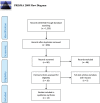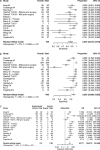Dual-Energy Computed Tomography in Spine Fractures: A Systematic Review and Meta-Analysis
- PMID: 33963025
- PMCID: PMC8176828
- DOI: 10.14444/8074
Dual-Energy Computed Tomography in Spine Fractures: A Systematic Review and Meta-Analysis
Abstract
Background: The purpose of this study was to perform a systematic literature review and meta-analysis to evaluate the sensitivity, specificity, and accuracy of dual-energy computed tomography (DE-CT) of bone marrow edema and disc edema in spine injuries.In vertebral injuries, prompt diagnosis is essential to avoid any delays in treatment. Conventional radiography may only reveal indirect signs of fractures, such as when it is displaced. Therefore, to detect the presence of bone marrow or disc edemas, adjunctive tools are required, such as magnetic resonance imaging (MRI) or DE-CT.
Methods: Search terms included ((DECT) OR (DE-CT) OR (dual-energy CT) OR "Dual energy CT" OR (dual-energy computed tomography) OR (dual energy computed tomography)) AND ((spine) OR (vertebral)), and the PubMed, EMBASE, and MEDLINE databases and the Cochrane Library and Google were used. We found 1233 articles on our preliminary search, but only 13 articles met all criteria. Data were extracted to calculate the pooled sensitivity, specificity, and diagnostic odds ratio for analysis using R software.
Results: Within the 13 studies, 515 patients, 3335 vertebrae, and 926 acute fractures (27.8%) defined by MRI were included. The largest cohort included 76 patients with 774 vertebrae. In 12 publications, MRI was reported for comparison. For DE-CT, the overall sensitivity was 86.2% with a specificity of 91.2% and accuracy of 89.3%. Furthermore, 5 studies reported the accuracy of CT with an overall sensitivity of 81.3%, specificity of 80.7%, and accuracy with 80.9%. Significant differences were found for specificity (P < .001) and accuracy (P = .023). However, significant interobserver differences were reported.
Conclusions: DE-CT seems to be a promising diagnostic tool to detect bone marrow and disc edemas, which can potentially replace the current gold standard, the MRI.
Level of evidence: 2.
Clinical relevance: This study shows that DE-CT seems to be a promising diagnostic tool with an accuracy of 89.3%.
Keywords: CT; DECT; bone marrow edema; computed tomography; disc edema; dual-energy; spine; vertebra.
This manuscript is generously published free of charge by ISASS, the International Society for the Advancement of Spine Surgery. Copyright © 2021 ISASS.
Conflict of interest statement
Figures





Similar articles
-
Comprehensive comparison of dual-energy computed tomography and magnetic resonance imaging for the assessment of bone marrow edema and fracture lines in acute vertebral fractures.Eur Radiol. 2022 Jan;32(1):561-571. doi: 10.1007/s00330-021-08081-8. Epub 2021 Jul 2. Eur Radiol. 2022. PMID: 34215940 Free PMC article.
-
Diagnostic accuracy of dual-energy computed tomography in bone marrow edema with vertebral compression fractures: A meta-analysis.Eur J Radiol. 2018 Feb;99:124-129. doi: 10.1016/j.ejrad.2017.12.018. Epub 2017 Dec 21. Eur J Radiol. 2018. PMID: 29362142 Review.
-
Dual-energy CT virtual non-calcium technique for detection of bone marrow edema in patients with vertebral fractures: A prospective feasibility study on a single- source volume CT scanner.Eur J Radiol. 2017 Feb;87:59-65. doi: 10.1016/j.ejrad.2016.12.008. Epub 2016 Dec 12. Eur J Radiol. 2017. PMID: 28065376
-
Single-source dual-energy computed tomography for the assessment of bone marrow oedema in vertebral compression fractures: a prospective diagnostic accuracy study.Eur Radiol. 2019 Jan;29(1):31-39. doi: 10.1007/s00330-018-5568-y. Epub 2018 Jun 15. Eur Radiol. 2019. PMID: 29948088
-
DECT in Detection of Vertebral Fracture-associated Bone Marrow Edema: A Systematic Review and Meta-Analysis with Emphasis on Technical and Imaging Interpretation Parameters.Radiology. 2021 Jul;300(1):110-119. doi: 10.1148/radiol.2021203624. Epub 2021 Apr 20. Radiology. 2021. PMID: 33876973
Cited by
-
The Role of Magnetic Resonance Imaging and Computed Tomography in Spinal Cord Injury.Life (Basel). 2023 Aug 3;13(8):1680. doi: 10.3390/life13081680. Life (Basel). 2023. PMID: 37629537 Free PMC article. Review.
-
Identification of Non-Traumatic Bone Marrow Oedema: The Pearls and Pitfalls of Dual-Energy CT (DECT).Tomography. 2021 Aug 26;7(3):387-396. doi: 10.3390/tomography7030034. Tomography. 2021. PMID: 34449751 Free PMC article.
-
Dual-energy CT: Impact of detecting bone marrow oedema in occult trauma in the Emergency.BJR Open. 2024 Sep 11;6(1):tzae025. doi: 10.1093/bjro/tzae025. eCollection 2024 Jan. BJR Open. 2024. PMID: 39345237 Free PMC article. Review.
-
Imaging of pelvic ring fractures in older adults and its clinical implications-a systematic review.Osteoporos Int. 2023 Sep;34(9):1549-1559. doi: 10.1007/s00198-023-06812-9. Epub 2023 Jun 7. Osteoporos Int. 2023. PMID: 37286662 Free PMC article.
References
-
- Atsina KB, Rozenberg A, Selvarajan SK. The utility of whole spine survey MRI in blunt trauma patients sustaining single level or contiguous spinal fractures. Emerg Radiol. 2019;26(5):493–500. - PubMed
-
- Komlosi P, Wintermark M. Dual energy computed tomography applications for the evaluation of the spine. Neuroimaging Clin N Am. 2017;27(3):483–487. - PubMed
-
- Wang CK, Tsai JM, Chuang MT, Wang MT, Huang KY, Lin RM. Bone marrow edema in vertebral compression fractures: detection with dual-energy CT. Radiology. 2013;269(2):525–533. - PubMed
-
- Tanigawa N, Komemushi A, Kariya S, et al. Percutaneous vertebroplasty: relationship between vertebral body bone marrow edema pattern on MR images and initial clinical response. Radiology. 2006;239(1):195–200. - PubMed
-
- Brooks RA. A quantitative theory of the Hounsfield unit and its application to dual energy scanning. J Comput Assist Tomogr. 1977;1(4):487–493. - PubMed
LinkOut - more resources
Full Text Sources
Other Literature Sources
Research Materials
Miscellaneous
